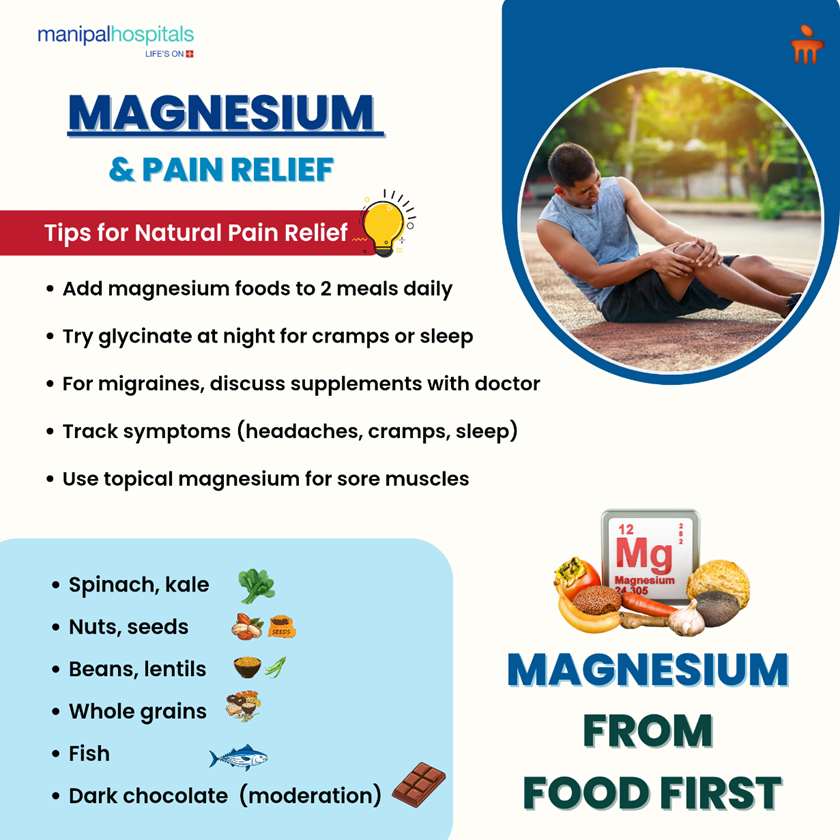Pain is something you feel in many ways: a throbbing muscle after exercise, a sharp nerve pain, a migraine, or monthly period cramps. You might be surprised that a simple mineral like magnesium can help with several of these pains. Magnesium plays a quiet yet important role in nerve signalling, muscle relaxation, and inflammation control. Knowing how magnesium for pain works, where it helps most, and how to use it safely can give you practical options to feel better. This blog explains the role of magnesium in pain, the kinds of pain it can influence, the science behind it, and simple steps you can take at home or discuss with your doctor.
Synopsis
What is Magnesium? Its Role
Magnesium is a vital mineral involved in over 300 biochemical reactions in your body. It helps your nerves fire properly and your muscles relax. When magnesium levels fall, muscles may cramp, nerves may be more excitable, and inflammation can rise. Those changes can translate into different kinds of pain. The role of magnesium in the matter of pain includes:
-
It calms nerve activity by regulating NMDA receptors
-
It relaxes muscle fibres, reducing cramping and tightness, and reduces inflammation markers linked to chronic pain
-
It supports blood vessel tone, which matters in headaches and migraines
So, magnesium doesn’t treat every pain directly. But it influences several pathways that cause or worsen pain. That’s why it’s been studied for a range of pain conditions.
Types of Pain Where Magnesium Can Help
Here’s a practical look at the common pain types, where magnesium can make a difference.
1. Muscle Pain and Cramps
If you wake up with leg cramps or feel tight after exercise, magnesium for muscle pain can be useful. Magnesium helps muscles relax and prevents prolonged contractions that feel painful. Athletes and older adults often benefit from magnesium when cramps are frequent.
2. Migraines and Headaches
Research shows magnesium can reduce migraine frequency and intensity for many people. Magnesium helps stabilise blood vessels and calms nerve pathways involved in migraine. Low magnesium levels are more common in people who get recurrent migraines and headaches, so supplementation can be part of prevention.
3. Neuropathic Pain (Nerve Pain)
Nerve pain from diabetes, shingles, or surgery is hard to treat. Magnesium may help by modulating nerve excitability. It’s not a cure, but it can be an adjunct along with other treatments to reduce the impulse that makes nerves fire painfully.
4. Fibromyalgia and Widespread Pain
People with fibromyalgia often report better sleep and reduced pain with magnesium, especially when combined with lifestyle changes. Magnesium’s role in muscle relaxation and sleep support may explain some benefit.
5. Menstrual Cramps (Dysmenorrhea)
For many women, magnesium for menstrual pain provides relief by relaxing uterine muscles and reducing prostaglandin-driven cramping. It’s gentle, natural, and often helpful alongside other measures.
6. Chronic Low Back Pain and Tension
Where muscle tightness or nerve irritation contributes to back pain, correcting magnesium deficiency can reduce muscle spasm and improve comfort. It’s one part of a broader plan that includes exercise and physiotherapy.

What Does the Evidence Say?
Studies show a mix of promising results and areas needing more research. For migraines, several clinical trials support magnesium supplementation to reduce frequency. For muscle cramps, magnesium helps some people, especially those with low baseline levels. In neuropathic pain and fibromyalgia, results vary, but many patients report symptomatic improvement when magnesium is added to a treatment plan.
The Takeaway: Magnesium is not a magic bullet. But for many, it’s a low-risk, low-cost addition that improves symptoms and complements medical care.
How to Use Magnesium? Food First, Then Supplements
Start by looking at your diet. Food sources help maintain steady levels and carry fewer risks than supplements.
Foods Rich in Magnesium
-
Leafy green vegetables (spinach, kale)
-
Nuts and seeds (almonds, pumpkin seeds)
-
Whole grains (brown rice, oats)
-
Legumes (beans, lentils)
-
Fish (mackerel, salmon)
-
Dark chocolate (in moderation)
If diet isn’t enough or you have persistent symptoms, supplements can help. Choices matter!
Common Supplement Forms
-
Magnesium Citrate: good absorption, may act as a mild laxative
-
Magnesium Glycinate: gentle on the stomach, good for sleep, and cramps
-
Magnesium Oxide: less absorbed, is often used for bowel benefits
-
Topical Magnesium (oils or creams): used by some for local muscle soreness, though evidence is limited
Typical Dosing: Daily doses used in studies vary from 200 mg to 600 mg elemental magnesium. A reasonable approach is to aim for the Recommended Dietary Allowance first (around 310–420 mg daily for adults, depending on age and sex), then supplement under medical advice if needed.
Safety Notes: Too much magnesium from supplements can cause diarrhoea, nausea, and stomach cramps. In people with kidney disease, magnesium can build up and cause serious problems. Check interactions if you take blood pressure medicines, diuretics, or muscle relaxants.
When to See a Doctor?
If pain is severe, sudden, or worsening, consult a top Neurosurgeon in Bhubaneshwar at the Mnaipal Hospitals. Magnesium is a supportive measure, not a replacement for urgent care. Talk to your doctor if:
-
Pain starts suddenly and intensely
-
You suspect nerve damage or weakness
-
You have kidney disease or take multiple medicines
-
You try magnesium for a month without benefit, and symptoms persist
A tailored plan that may include imaging, physiotherapy, medications, or specialist input can give you the best outcomes.
Check Out Our Other Blog Posts: 7 Innovative Brain Tumour Treatment Options
Conclusion
Magnesium helps with many kinds of pain, from muscle cramps and migraines to some nerve-related pains and menstrual cramps. It works best when part of a wider plan: balanced diet, exercise, sleep, and medical care when needed. If you think magnesium for pain could help you, talk to your doctor about testing levels and choosing the right dose and form.
At Manipal Hospitals, the Department of Neurosurgery and pain teams combine clinical expertise with practical advice. Take the first step - book an appointment and let’s find a plan that helps you feel better.
FAQ's
Magnesium may assist with cramps, but it usually works for days to weeks. Stretching, drinking water, and heat can often help right away. Think of magnesium as a prevention strategy rather than a rescue remedy.
Magnesium glycinate works well for a lot of people. It's mild and helps you sleep and relax your muscles. Magnesium citrate may help if you are experiencing difficulty with urination or bowel movements.
Some people with magnesium supplements feel better in a few days. For headaches and chronic pain, benefits often show after 4–12 weeks. Keep a symptom diary to track changes.
Most of the time, yes, but talk to your doctor. Magnesium can affect some blood pressure medications, antibiotics, and diuretics. Talk about safety first if you have kidney disease.
Total body magnesium levels don't always match blood magnesium levels. Testing can help in some situations, especially if you've been using it for a long time or have kidney problems. Your doctor will give you advice based on your past.





















 6 Min Read
6 Min Read








9.png)






